SuperKEKB aims to break the record of the collision of particles per second. This phenomenon is known as brilliance among researchers. SuperKEKB has registered early in the morning of April 26 the first collisions among electrons and positrons. It has been possible thanks to Belle II, an experiment aiming to find the answers to the origin and composition of the Universe. The Institute of Corpuscular Physics (IFIC) of the Universitat de València and the CSIC participate in an international collaboration of more than 25 countries involved.
Electrons and positrons were accelerated and stocked piled by the accelerator SuperKEKB. They have collided for the first time at 12.38 a.m. of April 26 in Tsukuba, Japan. Belle II detector is located in the site where collisions take place. It has registered the annihilation that is produced between the beams of electrons and positrons. It produces other particles as quarks (pieces that make up matter) and antiquarks b (beauty), which is one of the heaviest quarks. These are the first collisions that has been registered in the accelerator of the Japanese Organisation for Research on High Energy Physics with Accelerators (KEK) since the previous machine (KEKB) finished its operations in 2010.
Belle II detector has been designed and built by an international collaboration of more than 750 researchers coming from 25 countries, including Spain. If we compare it with its predecessor (Belle), the new detector has highly improved its capability. It can detect and reconstruct events in a much higher speed, by taking advantage of the fact that SuperKEKB will have 40 times more brilliance (measure of the number of collisions) than the previous accelerator. 50 billion collision events between B-mesons and anti-B (particles made up of a quark and an antiquark b) are expected to happen. This is 50 times more than the data that was obtained in the previous project KEKB/Belle that worked for 10 years.
SuperKEKB and Belle II detector are designed to search “New Physics” beyond the Standard Model, the theory that describes the elemental particles that make up the visible matter of the Universe and its interactions. Belle II will search evidence of the existence of new particles that might explain why the Universe is ruled by matter instead of antimatter. This is a mystery since they were produced in similar quantities after the Big Bang. They also intend to answer other fundamental questions for the knowledge of cosmos.
Unlike the Large Hadron Collider (LHC) of the CERN in Geneva (Switzerland), which is the larger and most powerful proton accelerator in the World, SuperKEKB is designed to be the accelerator with more brilliance. Brilliance is the measure of the number of potential collisions in an accelerator per unit area in a certain period of time. Thus, SuperKEKB is a leader in what is called “frontier of brilliance” and expects to break the record of brilliance, which was already beaten in 2009 by its predecessor, KEKB.
Carlos Mariñas, doctor by the IFIC and currently working at the University of Bonn as adjunct coordinator of the performance of Belle II, states that “detecting the first collisions is a great achievement of the teams involved in the implementation process of the beams during the past months. The great experience of the Japanese physics of accelerators has brought us to this point in very little time, allowing us to switch on Belle II progressively without risking the experiment. It is now in the hands of the physics who work in the detector to bring out the best of the potential of such discovery, which is possible to conduct thanks to this incredible machine. We are eager to accept the challenge.”
The Institute of Corpuscular Physics (IFIC, Joint centre CSIC-Universitat de València), the Cantabrian Institute of Physics (IFCA, joint centre CSIC-Universidad de Cantabria) and the Aragonese Institute of Technology (ITAINNOVA) participate in the design, construction, installation and performance of DEPFET, a new detector for the experiment Belle II.
The IFIC of Valencia participates for over a decade in the development of DEPFET. First, it coordinated the tests with beams of particles. Then, it studied the strategy of refrigeration for the detector. In fact, this strategy was the result of the doctoral thesis of Carlos Mariñas, currently working in the University of Bonn and one of the responsible of Belle II. In addition, IFIC has designed and produced the electronics to check that the modules of DEPFET work properly after been connected to Belle II.


